Abstract
Recommendations on the use of an aerosol turbulent lidar for research in the atmospheric boundary layer are given. A feature of a turbulent lidar is that the sounding path angle should not exceed 10°. It is found that the optimal path angle is 4°, at which it is possible to determine the structural parameter of the refractive index \(C_{n}^{2}\) in the altitude range from 100 m to 1 km. This range can be doubled if sounding at two or three angles to the horizon.




Similar content being viewed by others
REFERENCES
Laser monitoring of the atmosphere, Ed. by E.D. Hinkley (Springer, Berlin, Heidelberg 1976).
G. G. Gimmestad, D. W. Roberts, J. M. Stewart, and J. W. Wood, “Development of the lidar technique for the profiling optical turbulence,” Opt. Eng. 51 (10) (2012). https://doi.org/10.1117/1.OE.51.10.101713
V. A. Banakh and I. A. Razenkov, “Lidar measurements of atmospheric backscattering amplification,” Opt. Spectrosc. 120 (2), 326–334 (2016).
A. G. Vinogradov, A. S. Gurvich, S. S. Kashkarov, Yu. A. Kravtsov, and V. I. Tatarskii, Invention Certificate No. 359, Byull. Izobret., No. 21 (1989).
A. G. Vinogradov, Yu. A. Kravtsov, and V. I. Tatarskii, “Backscatter effect on bodies placed inside a randomly inhomogeneous medium,” Izv. Vyssh. Ucheb. Zaved. Radiofiz. 16 (7), 1064–1070 (1973).
A. S. Gurvich, “Lidar sounding of turbulence based on the backscatter enhancement effect,” Izv. Atmos. Ocean. Phys. 48 (6), 585–594 (2012).
A. S. Gurvich, RF Patent No. 116245, Byull. Izobret., No. 5 (2012).
A. L. Afanasiev, A. S. Gurvich, and A. P. Rostov, “Experimental study of the backscatter enhancement effect in a turbulent atmosphere,” in Proc. of XVIII Intern. Symp. “Atmospheric and Ocean Optics. Atmospheric Physics ", Irkutsk, 2012 (Publishing House of IAO SB RAS, Tomsk, 2012), p. C95–C99 [in Russian].
I. A. Razenkov, V. A. Banakh, and A. I. Nadeev, RF Utility Patent No. 153460, Byull. Izobret., No. 6 (2015).
I. A. Razenkov and V. A. Banakh, RF Patent No. 165087, Byull. Izobret., No. 10 (2016).
Yu. A. Kravtsov and A. I. Saichev “Effects of double passage of waves in randomly inhomogeneous media”, Physics-Uspekhi, 25, 494–508 (1982)
I. A. Razenkov, “Turbulent lidar: I—Design,” Atmos. Ocean. Opt. 31 (3), 273–280 (2018).
I. A. Razenkov, “Turbulent lidar: II—Experiment,” Atmos. Ocean. Opt. 31 (3) 281–289 (2018).
I. A. Razenkov, “Estimation of the turbulence intensity from lidar data,” Atmos. Ocean. Opt. 33 (3), 245–253 (2020).
V. A. Banakh and I. A. Razenkov, “Refractive Turbulence Strength Estimation Based on the Laser Echo Signal Amplification Effect,” Opt. Lett. 41 (2016).
I. A. Razenkov, “Optimization of parameters of a turbulent lidar,” Atmos. Ocean. Opt. 32 (3), 349–360 (2019).
V. A. Banakh, A. V. Falits, and I. V. Zaloznaya, “Amplification of the mean power of the echo signal of a spatially limited laser beam in a turbulent atmosphere,” Opt. Atmos. Okeana 32 (5), 371–375 (2019).
V. V. Vorob’ev, “On the applicability of asymptotic formulas of retrieving "optical” turbulence parameters from pulse lidar sounding data: II—Results of numerical simulation,” Atmos. Ocean. Opt. 30 (2), 162–168 (2017).
A. S. Gurvich, A. I. Kon, V. L. Mironov, and S. S. Khmelevtsov, Laser Radiation in a Turbulent Atmosphere (Nauka, Moscow, 1976) [in Russian].
I. A. Razenkov, V. A. Banakh, and E. V. Gorgeev, “Lidar "BSE-4" for the atmospheric turbulence measurements,” Proc. SPIE—Int. Soc. Opt. Eng. (2018). https://doi.org/10.1117/12.2505183
http://attex.net/RU/index.php. Cited March 15, 2020.
ACKNOWLEDGMENTS
The author is grateful to A.P. Rostov for the advice, useful discussion of the results of the work, and the help in organizing scintilllometer measurements of the turbulence strength.
Funding
The was performed within Project of Fundamental Research of the Russian Academy of Sciences no. AAAA-A17-117021310149-4.
Author information
Authors and Affiliations
Corresponding author
Ethics declarations
The authors declare that they have no conflict of interests.
Additional information
Translated by O. Ponomareva
Rights and permissions
About this article
Cite this article
Razenkov, I.A. Specifics of Sounding the Atmospheric Boundary Layer with a Turbulent Lidar. Atmos Ocean Opt 33, 610–615 (2020). https://doi.org/10.1134/S1024856020060123
Received:
Revised:
Accepted:
Published:
Issue Date:
DOI: https://doi.org/10.1134/S1024856020060123




